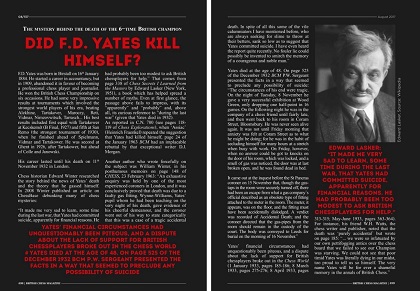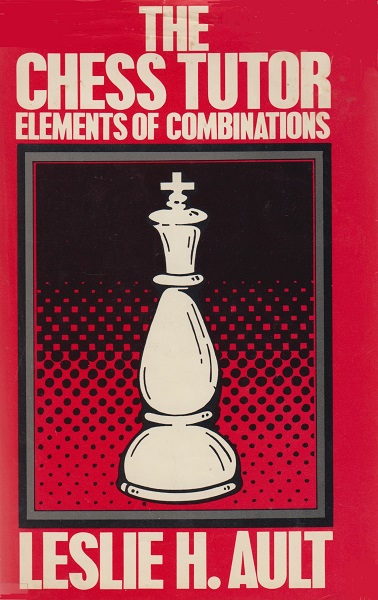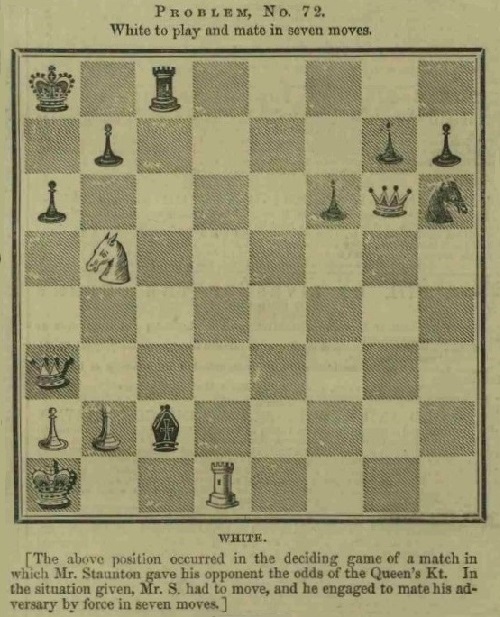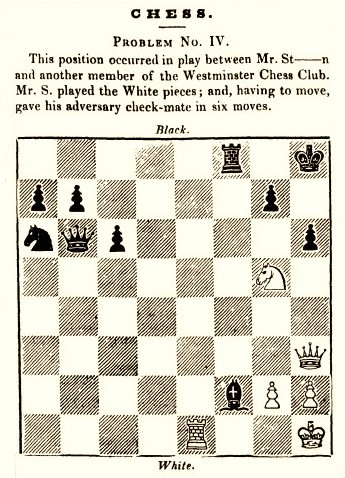Chess Notes
Edward Winter
When contacting us by e-mail, correspondents are asked to include their name and full postal address and, when providing information, to quote exact book and magazine sources. The word ‘chess’ needs to appear in the subject-line or in the message itself.
| First column | << previous | Archives [157] | next >> | Current column |
10538. The BCM
From Olimpiu G. Urcan (Singapore):
‘Having bought a digital edition of the August 2017 BCM (“Editors: Milan Dinic and Shaun Taulbut”), I saw on pages 498-499 an unsigned article “Did F.D. Yates Kill Himself?”:
You are mentioned briefly near the beginning, but everything (all the facts, quotes, etc.) about Yates’ death in the entire article has been copied from your work, and without mention of your (active) feature article.
That leaves just the BCM’s general introductory paragraph on Yates’ career. It has been lifted from Wikipedia.
So more or less the only “contribution” by the BCM itself is a Wikipedia-sourced photograph of Emanuel Lasker. The magazine identifies him as “Edward Lasker”.’
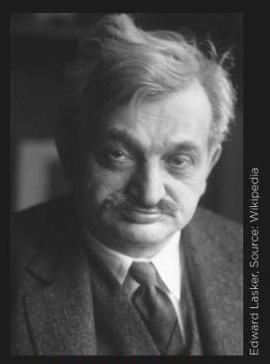
10539. A brilliancy prize game
Eduardo Bauzá Mercére (New York, NY, USA) submits this game:
C. Berry – P. Layzell
City of London Winter Tournament, 1896-97
Queen’s Gambit Declined
1 d4 d5 2 c4 e6 3 Nc3 Nf6 4 e3 c5 5 Nf3 Nc6 6 cxd5 exd5 7 a3 c4 8 Be2 a6 9 O-O Bd6 10 b3 b5 11 b4 Bd7 12 Nd2 O-O 13 f4 Qe7 14 Nf3 Rae8 15 Ne5 Bc7 16 g4 Qd6 17 Qc2 g6 18 h4 Re6 19 Rf2 Ne8 20 g5 f6 21 Ng4 fxg5 22 hxg5 Ne7 23 Bd2 Nf5 24 Rh2
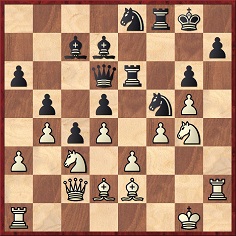
24...Nxe3 25 Bxe3 Rxe3 26 Nxe3 Qxf4 27 Nf1 Qxd4+ 28 Kh1 Bf5 29 Qd2 Be4+ 30 Nxe4 Qxe4+ 31 Rg2 Rf2 32 Ne3 Qh4+ 33 Kg1 Bh2+ 34 Kh1 Bg3+ 35 Kg1 Rxg2+ 36 Kxg2 Qh2+ 37 Kf3 Qf2+ 38 Kg4

38...Nf6+ 39 gxf6 h5+ 40 Kg5 Bh4+ 41 Kxg6 Qxf6+ 42 Kxh5 Qg5 mate.
From page 3 of the Morning Post, 12 July 1897:
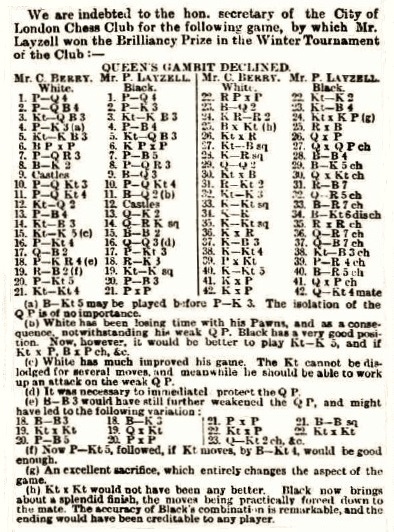
Our correspondent mentions that the game had also been annotated on page 10 of the London Evening Standard, 22 June 1897.
10540. Fine on Capablanca
C.N. 10515 gave some ‘once’ quotes from Chess Words of Wisdom by Mike Henebry (Victorville, 2010), and one more will suffice for now, from page 371:
‘Rueben [sic] Fine once said, “What others could not see in a month’s study, he saw at a glance” (Capablanca’s Best Chess Endings, Irving Chernev).’
Why mention Chernev when Fine’s famous remark is easily found on page 111 of his book The World’s Great Chess Games (New York, 1951 and London, 1952)?
Fine had originally published his words on page 288 of Chess Review, October 1943:

It will be noted that Fine consistently wrote ‘What others could not discover’, and not ‘see’, which was Chernev’s small misquotation in Capablanca’s Best Chess Endings, Combinations The Heart of Chess and The Golden Dozen. Chernev put ‘discover’ in Wonders and Curiosities of Chess. The respective page numbers in these four Chernev books are 60, 227, 279 and 55.
When Cyrus Lakdawala gave the Fine sentence, sourcelessly, on page 7 of his book on Capablanca (C.N. 7742), the verb was ‘find’.
Finally, there is the individual who took Fine’s words and presented them as his own:
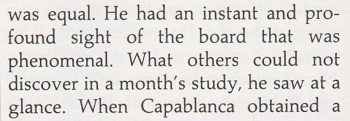
Source: page 37 of The Batsford Chess Encyclopedia by Nathan Divinsky (London, 1990).
10541. Early Smyslov studies
Andrey Terekhov (Singapore) forwards a news item on page 4 of the 48/1936 issue of 64:
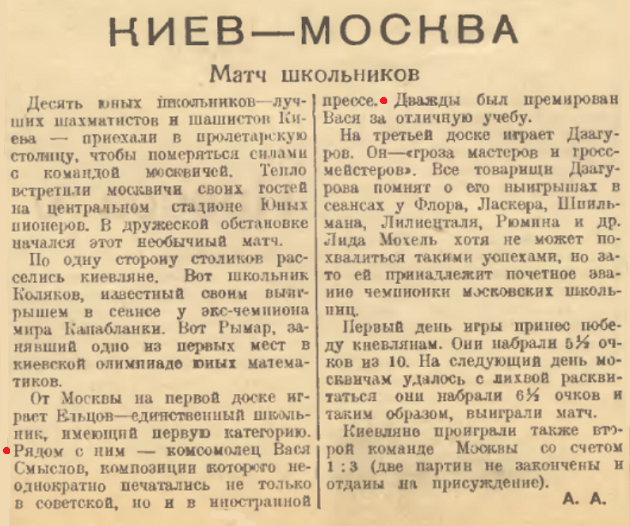
This report on a Kiev-Moscow schoolchildren’s match mentions Smyslov as a composer of chess studies published not only nationally but also abroad. Our correspondent asks whether 64 was correct and, if so, where Smyslov’s compositions were published outside the Soviet Union in or before 1936.
10542. John Gilbert
In connection with a photograph of Alekhine in Hollywood, C.N. 5922 referred to the actor John Gilbert (1899-1936). Information about his possible interest in chess is sought.
His daughter Leatrice Gilbert Fountain wrote a biography of him, Dark Star (London, 1985), and on page 253 she recalled that on Christmas Eve 1935, when she was 11, the many gifts (‘wonderful impractical things’) which John Gilbert gave her included an ivory chess set.

10543. An inscription by Botvinnik
From the title page of volume one of our set of Shakhmatnoe tvorchestvo Botvinnika (Moscow, 1965, 1966 and 1968):

We take the recipient of Botvinnik’s regards and thanks to be the psychiatrist Andrei Vladimirovich Snezhnevsky (1904-87).
10544. Blumberg (C.N.s 10518 & 10519)
Gerard Killoran (Ilkley, England) notes that Blumberg appeared in a group photograph on page 10 of the New-York Daily Tribune, 22 December 1907:
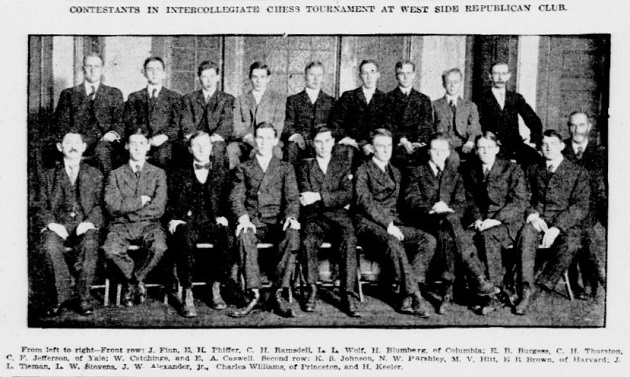
As regards Blumberg’s forename, we add this entry on page 81 of Columbia University Alumni Register 1754-1931 (New York, 1932):
‘Blumberg, Henry A.B. 1907, A.M. 1908.’
It was followed by a symbol indicating ‘address unknown (recorded address out of date)’.
Columbia University records at the Hathi Trust Digital Library include the following:
- Columbia University Quarterly, Volume XV, 1912-13, page 101: ‘Mr Henry Blumberg, A.B. and A.M. (Columbia) and fellow in mathematics 1909-10, continued the study of mathematics in Europe during 1910-12 and last spring passed the public examination for the degree of Ph.D. at Göttingen magna cum laude.’
- Columbia University Quarterly, Volume XVI, 1913-14, page 97: ‘Dr Henry Blumberg, once a fellow and for some time graduate student at Columbia, has accepted an instructorship in mathematics at the University of Nebraska.’
10545.
Austrian postage stamps
C.N.s 3680, 3681, 3689 and 9904 (see Chess and Postage Stamps)
showed Austrian stamps featuring Alekhine, Capablanca,
Fischer, Kasparov, Rubinstein and Mieses.
We have a few others, including portraits of Steinitz,
Lasker and Smyslov:
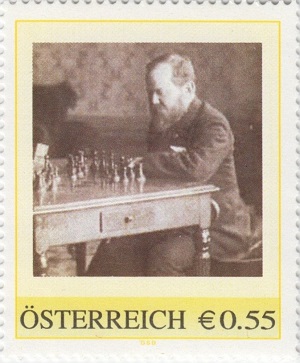


10546. Emanuel Lasker and hypnosis
From page 143 of Combinations The Heart of Chess by Irving Chernev (New York, 1960):
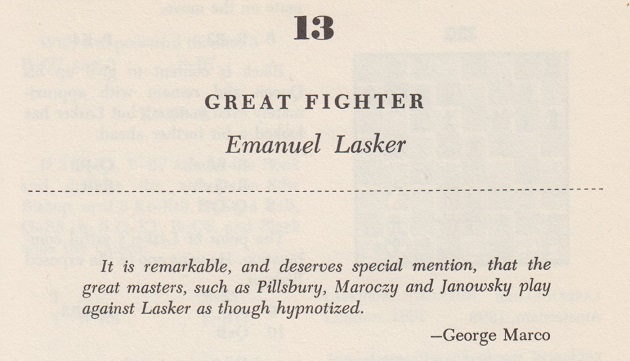
Chernev included Georg Marco’s observation in a number of books, having featured it as the ‘thought for the month’ on the inside front cover of the November 1954 Chess Review.
No source was ever offered, but below is Marco’s presentation of Janowsky v Lasker, Paris, 1900 on pages 149-150 of the July 1900 Wiener Schachzeitung:

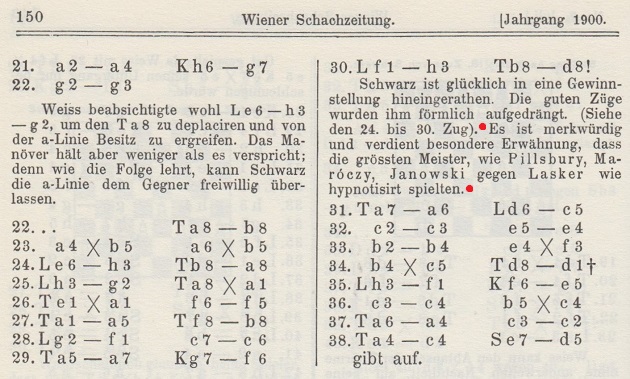
1 e4 e5 2 Nf3 Nc6 3 Bb5 a6 4 Ba4 Nf6 5 O-O d6 6 d4 b5 7 dxe5 dxe5 8 Bb3 Qxd1 9 Rxd1 Bd6 10 Bg5 Be6 11 Nc3 O-O 12 Bxf6 gxf6 13 Nd5 f5 14 exf5 Bxf5 15 Nf6+ Kg7 16 Nh5+ Kh6 17 Ng3 Ne7 18 Re1 f6 19 Nxf5+ Nxf5 20 Be6 Ne7 21 a4 Kg7 22 g3 Rab8 23 axb5 axb5 24 Bh3 Ra8 25 Bg2 Rxa1 26 Rxa1 f5 27 Ra5 Rb8 28 Bf1 c6 29 Ra7 Kf6 30 Bh3 Rd8 31 Ra6 Bc5 32 c3 e4 33 b4 exf3 34 bxc5 Rd1+ 35 Bf1 Ke5 36 c4 bxc4 37 Ra4 c3 38 Rc4 Nd5. According to pages 60-62 of Samuel Rosenthal’s Paris, 1900 tournament book, a few additional moves were played: 39 h4 h5 40 g4 fxg4 41 Kh2 Rxf1 42 White resigns.
Around the same time, Miron James Hazeltine also referred to hypnosis in connection with Lasker and the Paris tournament, on page 398 of the New York Clipper, 30 June 1900:
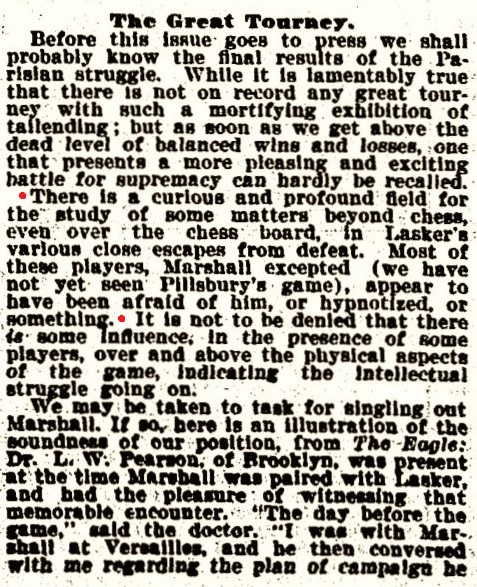
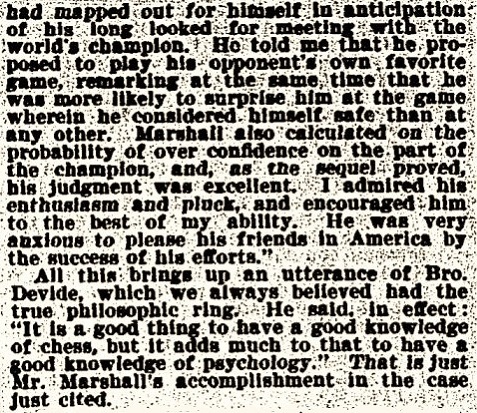
See too Chess and Hypnosis.
10547. Neglected books (C.N. 10529)
From Sean Robinson (Tacoma, WA, USA):
‘Concerning neglected books, I nominate Leslie Ault’s The Chess Tutor: Elements of Combinations (New York, 1975), for its quality and historical resonance. It is not just a neglected book – it is a neglected Fischer book. Under different circumstances, it might have become Bobby Fischer Teaches Chess II.
As you noted in C.N. 7375, Leslie Ault’s late brother Robin, a national junior champion, published a translation of Tarrasch’s Dreihundert Schachpartien in 1959 and 1961. Leslie Ault’s role in the best-selling chess book ever published, Bobby Fischer Teaches Chess (1966), is uncredited and perhaps unappreciated.
You touched on this topic in C.N. 6371. Leslie Ault, a US Intercollegiate champion, worked for Basic Systems, Inc., the publisher and educational subsidiary acquired by Xerox. He gave an account of his involvement on pages iv-v of his later (and also worthwhile) work The Genesis of Power Chess (Davenport, 1993):
“One of the executives, Stuart Margulies, knew me from chess tournaments and figured my chess ability would transfer to instructional writing. Unknown to me, Stuart had a contract along with Donn Mosenfelder (for writing) and Bobby Fischer (for the name) to prepare a basic ‘chess program’, covering simple mating techniques in step-by-step fashion with active responding. After Donn was slowed down by an auto accident, I was asked to help him complete the manuscript on schedule.
... the book sat on the shelf until giant Xerox acquired our little company and pumped in cash to support it. I was given the job, nominally as ‘editor’, to get it ready for publication. ... Our job was to tidy up the text, make sure all analysis was accurate, and work with Bobby Fischer in integrating some of his own positions into the text.
While I knew Fischer by sight from various tournaments in my teens, I had never met him personally. At first he was suspicious and defensive, but soon he became very helpful and cooperative – all in all a fascinating experience to work with a genius on the verge of becoming a household name in America. The result, of course, was Bobby Fischer Teaches Chess, which continues in print today, certainly helped by Fischer’s name but also I believe because of its unique systematic presentation for beginners.”
Ault then described his next project:
“I was feeling that another book, written in a similar manner but concentrating on basic tactics, would be much more useful for aspiring players beyond the level of rank beginner. ... Originally, I was hoping to deal with Fischer myself, but his subsequent withdrawal from all public activity forced me to sell my manuscript on my own. This I was able to do, and the result was The Chess Tutor: Elements of Combinations (197[5], paper 1976). The paperback printing was just at the end of the fading Fischer boom ...”
The Chess Tutor: Elements of Combinations follows the “chess program" format of Bobby Fischer Teaches Chess with greater sophistication and increasing degrees of difficulty, using positions from actual games (largely Fischer games, including the 1972 world championship match). Although it is not on your list of books about Fischer, it may qualify.
Ault’s third book (mentioned above) focused on strategy, with a similar format. It included Fischer examples to a lesser degree, completing a minor trilogy.’
In the United Kingdom The Chess Tutor: Elements of Combinations was published in 1976 by Barrie & Jenkins, London. It received very little attention.
Also in 1976, the same publisher brought out The Chess Tutor: Opening Moves by Pierre R. Schwob and George F. Kane. Opposite the title page, Walter Korn was named as the General Editor of the ‘Chess Tutor series’ (two volumes).
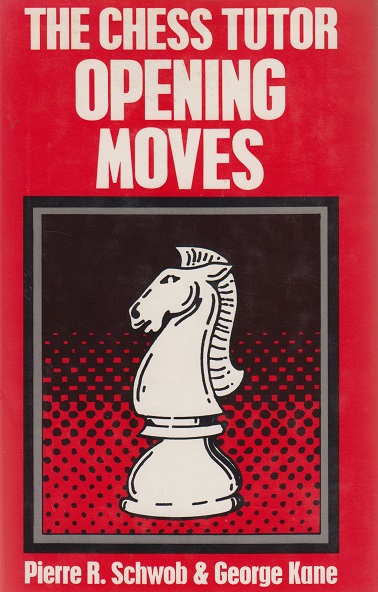
In the United States, both books were published by Mason/Charter, New York, and were advertised on page 335 of the June 1976 Chess Life & Review:

10548. Henry Blumberg (C.N.s 10518, 10519 & 10544)
Joseph Brennan (Orlando, FL, USA) reports that biographical information on Henry Blumberg is available at the Geni.com website. The entry states that he was born in Žagarė, Lithuania on 13 May 1886 and died in Columbus, OH, USA on 28 June 1950.
10549. A late Lipschütz game
Peter Anderberg (Harmstorf, Germany) writes:
‘On page 361 of Samuel Lipschütz. A Life in Chess (Jefferson, 2015) Stephen Davies gives a consultation game by cable in April 1903 as “Lipschütz’s last published game of chess”.
However, at least one game played during his stay in Hamburg in 1904-05 has survived (a draw against Julius Dimer), thanks to Martin Bier and his column in the Hamburgischer Correspondent of 7 January 1905 (page 2 of the “Abend-Ausgabe, 2. Beilage”):’
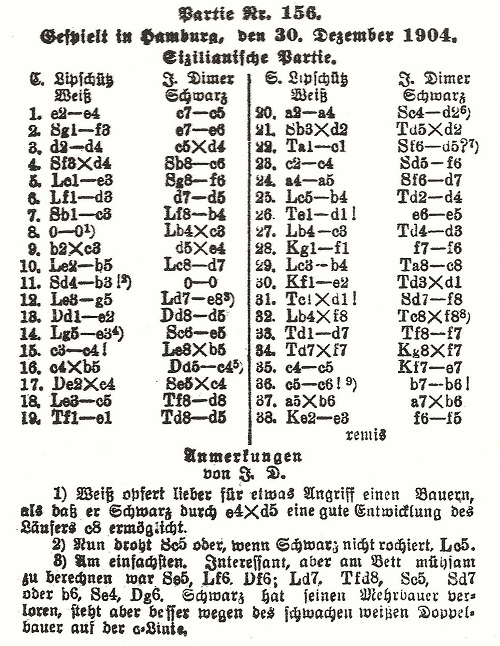
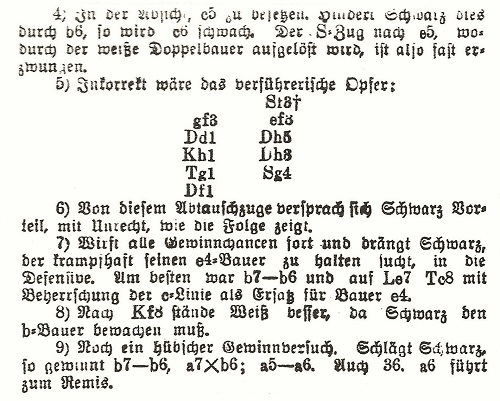
1 e4 c5 2 Nf3 e6 3 d4 cxd4 4 Nxd4 Nc6 5 Be3 Nf6 6 Bd3 d5 7 Nc3 Bb4 8 O-O Bxc3 9 bxc3 dxe4 10 Bb5 Bd7 11 Nb3 O-O 12 Bg5 Be8 13 Qe2 Qd5 14 Be3 Ne5
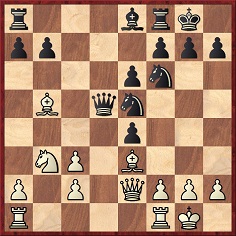
15 c4 Bxb5 16 cxb5 Qc4 17 Qxc4 Nxc4 18 Bc5 Rfd8 19 Rfe1 Rd5 20 a4 Nd2 21 Nxd2 Rxd2 22 Rac1 Nd5 23 c4 Nf6 24 a5 Nd7 25 Bb4 Rd4 26 Red1 e5 27 Bc3 Rd3 28 Kf1 f6 29 Bb4 Rc8 30 Ke2 Rxd1 31 Rxd1 Nf8 32 Bxf8 Rxf8 33 Rd7 Rf7 34 Rxf7 Kxf7 35 c5 Ke7 36 c6 b6 37 axb6 axb6 38 Ke3 f5 Drawn.
10550. Quotes about Lasker
From page iv of World’s Championship Matches, 1921 and 1927 (New York, 1977), in Irving Chernev’s 11-page Introduction to that Dover edition:
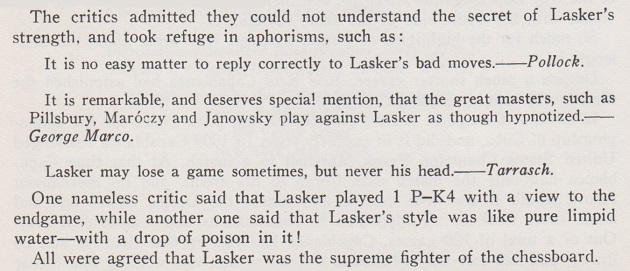
For the Pollock ‘aphorism’ (in the Hastings, 1895 tournament book), see our feature article on him. The source of Marco’s observation (Wiener Schachzeitung, 1900) was specified in C.N. 10546. The comment about P-K4 was discussed on page 297 of Chess Facts and Fables and in C.N. 9329. The water/poison remark was by Mieses (Berliner Tageblatt and the San Sebastián, 1911 tournament book), as shown in C.N.s 3160 and 3161 (see Chess: the Need for Sources).
That leaves Tarrasch’s remark, ‘Lasker may lose a game sometimes, but never his head’. It was on page 137 of Tarrasch’s book on St Petersburg, 1914:
‘Lasker verliert mitunter eine Partie, aber niemals den Kopf.’
It appeared in connection with Lasker’s move 24 Rc5 in his victory over Alekhine in the first round of the final section. Alekhine has just played 23...Nf5-e3:
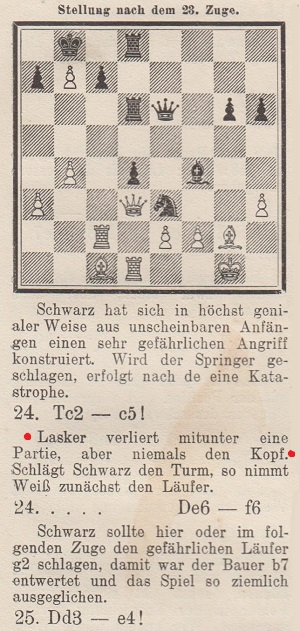
10551. Staunton problems
John Townsend (Wokingham, England) writes:
‘From Howard Staunton’s column on page 336 of the Illustrated London News, 24 May 1845:
A mirror-image of the position had appeared in Staunton’s column on page 338 of the New Court Gazette, 30 May 1840:
Mate in six cannot be achieved with the best defence by Black, viz. 1 Qf5 hxg5 2 Qxf8+ Kh7 3 Qf5+ g6 4 Re7+ Kh6 5 Qf8+ Kh5 6 Rh7+ Kg4 7 Qf3 mate.
Why did two very similar positions appear? If both accounts are to be believed, and the two problems represented a position which arose once in play, it would be the deciding game in a match at the odds of queen’s knight, played at the Westminster Chess Club before the end of 1839 (when the Club was dissolved). No such match by Staunton at those odds is on record.’
10552. John Carson Rather
The death of John Rather in 2013 has received little attention. He was a highly respected chess editor, bibliophile and bookseller. His contributions to C.N. included information, based on his position as a Chess Review staff writer, about the ghosting of material published in Reshevsky’s name.
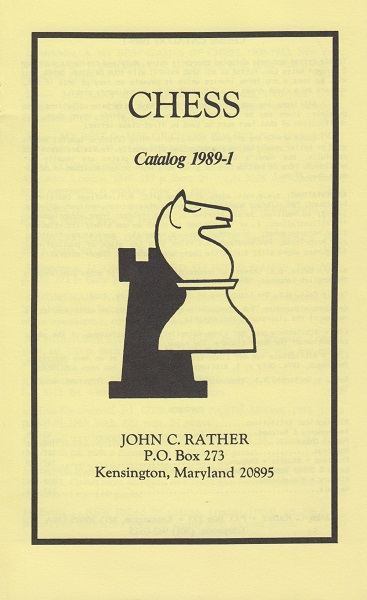
10553. A ‘new’ Zukertort book
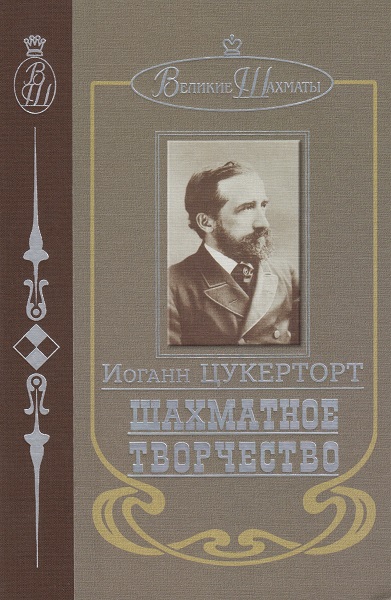

How soon, if at all, will readers of this 458-page hardback realize that it is a translation of Jimmy Adams’ work on Zukertort (Yorklyn, 1989 and Alkmaar, 2014)?
10554. Breyer
Just received: Gyula Breyer. The Chess Revolutionary by Jimmy Adams (Alkmaar, 2017). The title page of this 876-page hardback, an important work but a mixed blessing, adds: ‘In collaboration with Iván Bottlik. With translations from the Hungarian by Peter Szabó.’

A number of points will be highlighted in due course in Chess: the Need for Sources.
10555. Thirty years and three days
On page 873 of Gyula Breyer Jimmy Adams writes that he started the book over 30 years ago.
From page 350 of Grandmaster Insides by Maxim Dlugy (Ghent, 2017):
‘In 1989, I asked my friend Eric Schiller how he manages to write and publish so many books. He explained that he just compiles the information and then inserts simple to understand commentaries with basic tactics to explain the ideas.
He claimed it took him three days of work to put out a book.’
10556. Serafino Dubois
A particularly elegant recent book is Serafino Dubois by Fabrizio Zavatarelli (Brescia, 2017) – a limited edition of 99 numbered copies published by Messagerie Scacchistiche.
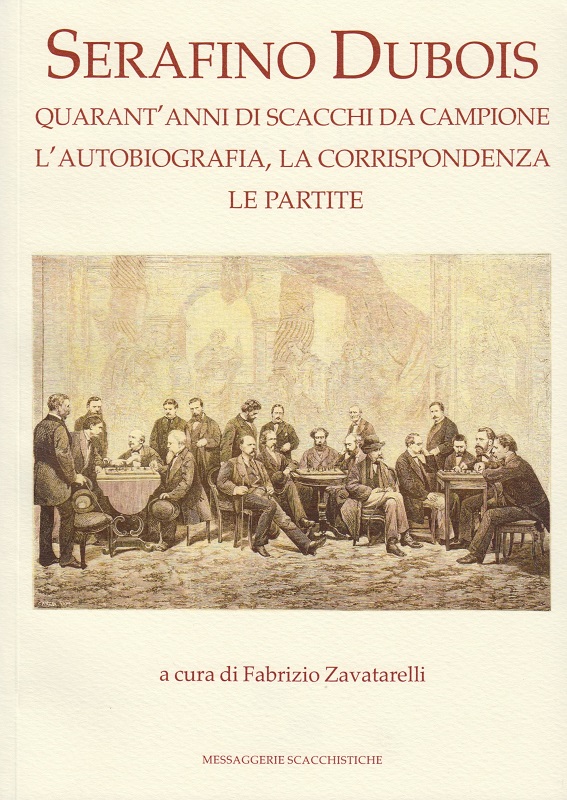
In his Introduction (page 5), the author assesses the standing of Dubois in Italian chess:
‘Serafino Dubois viene comunemente indicato non soltanto come il nostro più forte giocatore dell’Ottocento, ma anche come il più forte italiano in assoluto, se si eccettua la breve esperienza di Fabiano Caruana in azzurro.’
10557. A deciphering task
Readers who enjoy a deciphering task may care to examine this letter from our collection:
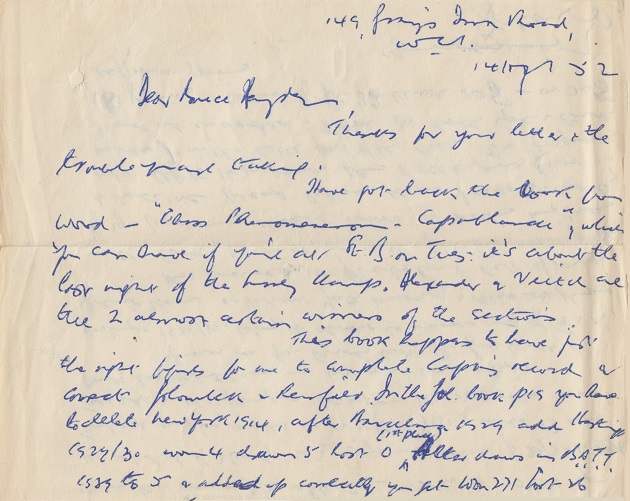
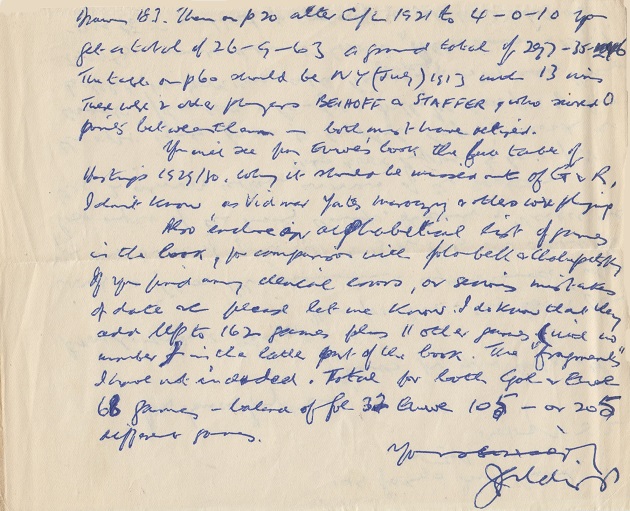
Larger versions: Part one Part two
The letter demonstrates that at least some of the countless factual mistakes in Capablanca’s Hundred Best Games of Chess by Harry Golombek (London, 1947) were quickly recognized. As shown in our feature article, the book has nonetheless been reprinted many times, by various publishers, without corrections being incorporated.
10558. Hamburg, 1930
John Donaldson (Berkeley, CA, USA) has forwarded this photograph:
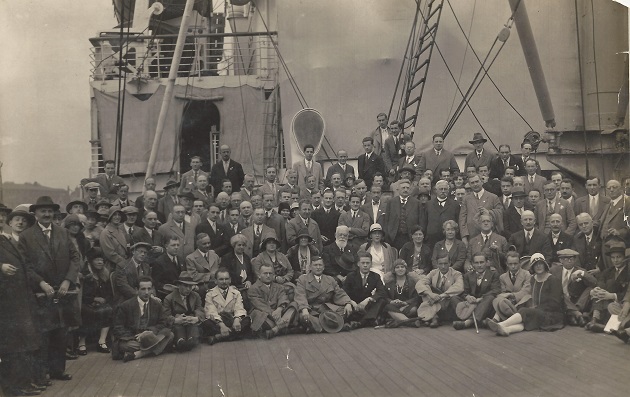
Credit: the World Chess Hall of Fame in St Louis, which received the photograph as a donation from Isaac Kashdan’s son Richard.
10559. Gangster Chess
From the Falkirk Herald, 11 May 1932:
‘“Gangster Chess”. I was told an amusing story the other day about the way Capone’s bodyguard[s] spend their leisure hours. When the hold-ups and shootings are over for the day, they play chess, at which some of them are extremely proficient. But what is even more interesting than that is that they have their own names for the pieces. Thus, it seems, pawns are “bootleggers”, knights are “gunmen”, bishops are “bombers”, rooks are “snappers”, while the queen is the “sweetie”, and the king is the “boss”. Mr P. Doubleyou in Pearson’s Weekly.’
The paragraph was repeated elsewhere (e.g. on page 8 of the Linlithgowshire Gazette, 13 May 1932), also with ‘bodyguard’ in the singular. Can the original item in Pearson’s Weekly be traced?
10560. As Réti ‘once’ said ...
Information is requested about this assertion on page 247 of Chess Words of Wisdom by Mike Henebry (Victorville, 2010):
‘As Réti once said, “One should be wary of easily understandable moves”.’
10561. Scarce books on Fischer
We have three editions (not the first, published in 2010) of Shakhmatny pamyatnik Fischeru by V.A. Leonov. Issued in Nizhny Novgorod and dated, respectively, 2011, 2016 and 2017, they are small-format, 62-page booklets.

An oddity is that the impressum page states that the print-run for the 2011 edition was 25 copies, and that only five copies of the two later editions were published.
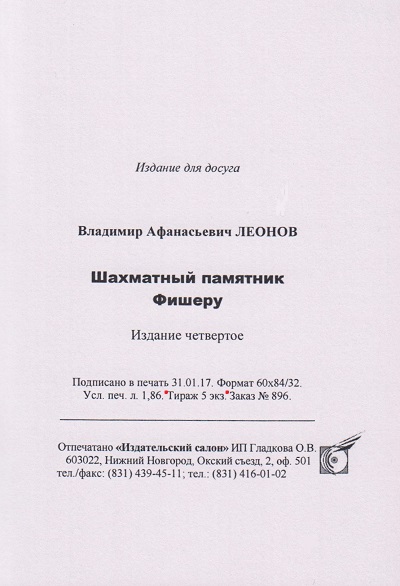
10562. Mrs Pillsbury (C.N. 9458)
Another photograph of H.N. Pillsbury’s wife is on page 147 of issue 38 of Womanhood, 1902. It is in the recent two-volume reprint of the Womanhood columns (of Rhoda A. Bowles) by Publishing House Moravian Chess, but is a clear version available from the original magazine?
10563. Breyer and sources (C.N. 10554)

One of the many reasons why a book should give precise sources is that they enable readers to check information independently. That process is often very difficult with Gyula Breyer. The Chess Revolutionary by Jimmy Adams (Alkmaar, 2017), as some examples will show.
- Marshall on Breyer
From pages 142-143:
‘Marshall remembered Breyer as a “tall, boyish, slim and happy-looking lad who played clever openings and knew more ‘book’ than any master” [Andrew Soltis in Frank Marshall: United States Chess Champion].’
The square brackets are from Adams’ book (as is the absence of italicization of ‘Marshall’). The passage is readily found in the Soltis book, whose index has only two references to Breyer, on page 199:

A point of detail is that the words ‘who played clever
openings and’ are not attributed to Marshall, but the main
point is that the reader is no further forward because, as
usual, Soltis is silent as to the exact provenance and
context of the alleged Marshall quote. His output cannot
be regarded as reliable, and the Breyer book demeans
itself by using it.
- Breyer v Tarrasch, Mannheim, 1914
Page 332 offers a typical example of how game annotations are sourced by Jimmy Adams:

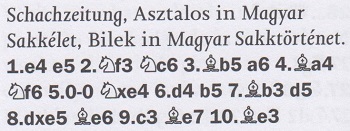
These bald references are of little help. To mention only the first one, Kagans Neueste Schachnachrichten did not begin publication until the decade after the Breyer v Tarrasch game was played. The onus is thus placed on the reader to research the matter, i.e. to track down Tartakower’s notes on pages 98-100 of the April 1922 issue.
Earlier, pages 13-15 of the Breyer book had the heading ‘Gyula Breyer is dead, but his spirit continues to be more alive than ever! by Dr Savielly Tartakower’. The source of that piece specified on page 15 is simply ‘Taken from Kagan’s Neueste Schachnachrichten and Die Hypermoderne Schachpartie’ with no indication as to which bits came from which publication.
- Golombek on Breyer
Pages 384-385 quote extracts from three Times columns by Harry Golombek (1975, 1977 and 1978), but only the years are specified. Full citations (exact dates and page numbers) were given in C.N. 5215, and the Breyer book thus takes a retrograde step by denying the reader complete information. (In one of the Golombek quotes, on page 385, ‘Tal’ has become ‘Szucs’, a typographical fault throughout the book.)
Citation of material from C.N., where there is any, is erratic and inconsistent. For instance, a small piece of information about Breyer’s address is credited on page 351 to ‘chesshistory.com’ (with a mention too of our own source), but that is an exception. The concluding pages acknowledge our website twice: there is a generous description on pages 872-873, and on page 876 ‘chesshistory.com’ is the only website mentioned in the ‘Quoted sources’ section. Such references are appreciated, but they do not steer readers to the exact location of specific information.
Sometimes, out of the blue, a more rigorous approach to sources is adopted by the book, and particularly when exact dates are given for Breyer’s own articles – a highlight of the book – from Hungarian publications.
- ‘White’s game is in the last throes’
Pages 694-696 deal with this matter, superficially, making no mention of Breyer and the Last Throes.
There is, though, a full page quoting Larry Evans (source specified: ‘From New Ideas in Chess’). Anyone who turns to Evans’ final edition of that book (Las Vegas, 2011) will find, on pages 25-29, a substantially different text, and it is therefore necessary to go back to the original edition (New York, 1958). The text quoted by Adams is on pages 12-15, but much of it has been silently excised from the Breyer book.
On the substantive issue of the alleged ‘last throes’ comment, Evans had merely a ‘once’ version in New Ideas in Chess:
‘Breyer once began annotating a game by giving 1 P-K4 a question mark, accompanied by the comment that “White’s game is in its last throes!”’
That is quoted without comment by Adams, who had nonetheless written on the previous page:
‘We have found no documentary evidence that Breyer really did make the “White’s game is in the last throes” comment, although his articles effectively did send that message!’
As noted in our above-mentioned feature article, Evans did not stand by his 1958 text, later coming up with a different account of the remark, with Breyer expunged and replaced by Réti. C.N. 6264 quoted from page 26 of the 1974 book Evans on Chess:
‘... Richard Reti, who in 1919 startled the chessworld by announcing that “White’s game is in its last throes” after 1 P-K4.’
A book on Breyer which pays attention to the output of Larry Evans, quoting him as if he were a credible authority, is asking for trouble. Incidentally, from the Breyer index (page 866) it is not immediately clear that Evans is mentioned in the book at all, since the reference to him on page 696 is among a list of page numbers (not all accurate) concerning the Evans Gambit.
- Alekhine on Breyer
Pages 795-797 have a feature headed as follows:

No date for the New York Times article is given by Adams, but there is a source at the bottom of page 797. A link, perhaps, to the online version of Alekhine’s article at the New York Times website? No. A link, perhaps, to Alekhine on Carlsbad, 1929, which has the full text, and the exact source (New York Times, 1 August 1929, pages 21 and 23)? No. A reference, perhaps, to C.N. 1274, which, over 30 years ago, gave Alekhine’s full text (also with the complete source)? No.
Instead, astoundingly, the Adams book has this at the end of Alekhine’s article:
‘Taken from Quarterly for Chess History.’
What are readers supposed to do with that? If they start wading through the 17 volumes of the Quarterly they will eventually find Alekhine’s article, on pages 161-163 of the 7/2001 issue, but it has the usual plethora of Olomouc typos (‘Maw Euwe’, ‘Capablanca, who reared [feared] that theory’, ‘The bent for crating [creating]’, etc.). Such evident mistranscriptions have been corrected in the Adams book, but why even consider using the Quarterly for Chess History in the first place? A small example of what will inevitably go wrong concerns a comment made by Alekhine after he referred to Breyer and Réti. According to the Quarterly, Alekhine wrote:
‘As representatives the present Carlsbad tournament of their interpretation we name ...’
Trying to make sense of that, the Breyer book (page 796) has opted for:
‘As representatives of their interpretation we name ...’
It would have been prudent to ignore the Quarterly
and check what Alekhine actually wrote, i.e.:
‘As representatives in the present Carlsbad tournament of their interpretation we name ...’
The article preceding Alekhine’s in the Breyer book (pages 793-795) provides another example of what may generously be called semi-sourcing, with this heading:
‘Results of the tournament in Moscow 1925. An article for Shakhmaty by the winner of the Moscow tournament, E.D. Bogoljubow.’
That is all: the bare name Shakhmaty.
Jimmy Adams’ approach to sources was referred to in the final paragraph of C.N. 8788 with regard to his monograph on Zukertort. C.N. 10555 noted that he began work on the Breyer book over 30 years ago. A few weeks’ extra effort, at the pre-typesetting stage, could easily have ensured the proper sourcing so obviously needed in a book with such rich historical content.
10564. Fauber on Breyer
It is a mercy that few chess authors have written prose like R.E. Fauber’s. From page 181 of his book Impact of Genius (Seattle, 1992):
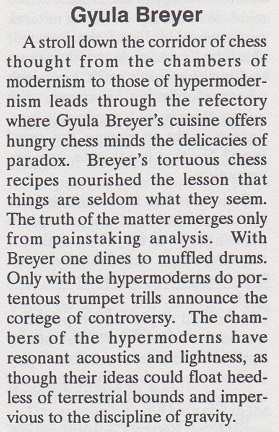
10565. ‘Probably unprecedented’
Eduardo Bauzá Mercére (New York, NY, USA) quotes a brief item from the Brisbane Courier, 17 February 1906, page 11, concerning the 50-move rule:
‘An Unusual Draw
The Cape Times reports that a very unusual case of a draw recently occurred at the Cape-town Chess Club. Mr A.J.A. Cameron, the winner of the handicap tourney of the current year, had to play his last tourney game with Mr J. Frank, to whom he had to concede the odds of the queen’s knight. Each of the players made 50 moves without a capture, and the position arrived at was such that neither player could break through without the sacrifice of a piece. Consequently, under the following clause of the British Chess Code the game was declared drawn: “A game in which checkmate has not occurred is treated as drawn if, before touching a man, the player, whose turn it is to play, claims that the game be treated as drawn, and proves that the last 50 moves on each side have been made without a capture.” The Cape Times characterizes the occurrences as “probably unprecedented”.’
10566. Horowitz on Anderssen
An inscription by Al Horowitz in one of our copies of his book How to Win in the Middle Game of Chess (New York, 1955):
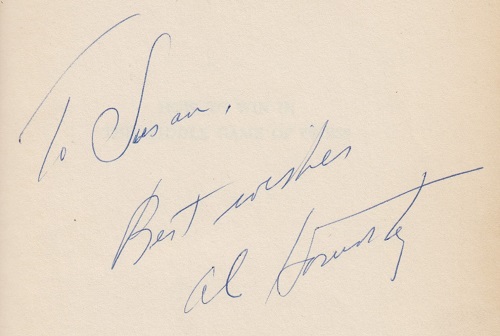
From pages 45-46:
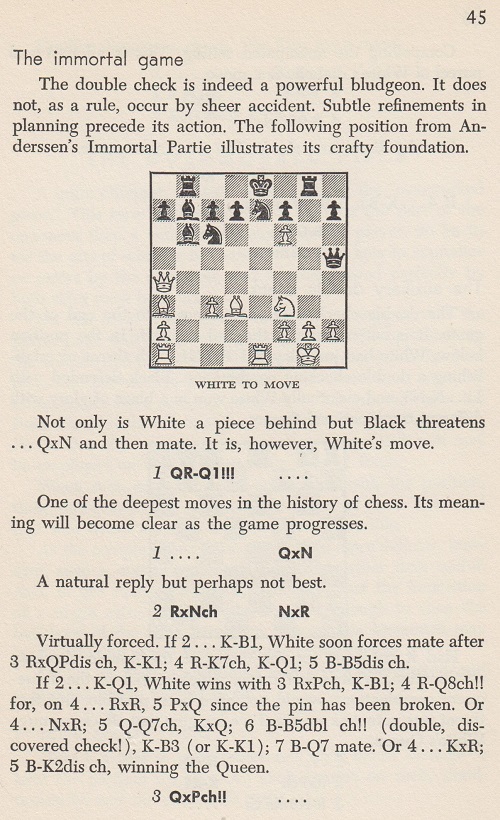
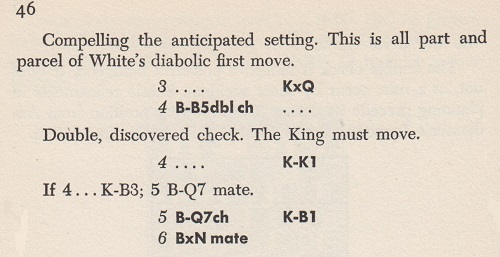
On page 202 of the July 1953 Chess Review Horowitz had given the same material, also mistitled ‘The Immortal Game’.
10567. Singapore Chess
The latest arrival is Singapore Chess. A History, 1945-1990 by Shashi Jayakumar and Olimpiu G. Urcan (Singapore, 2017):

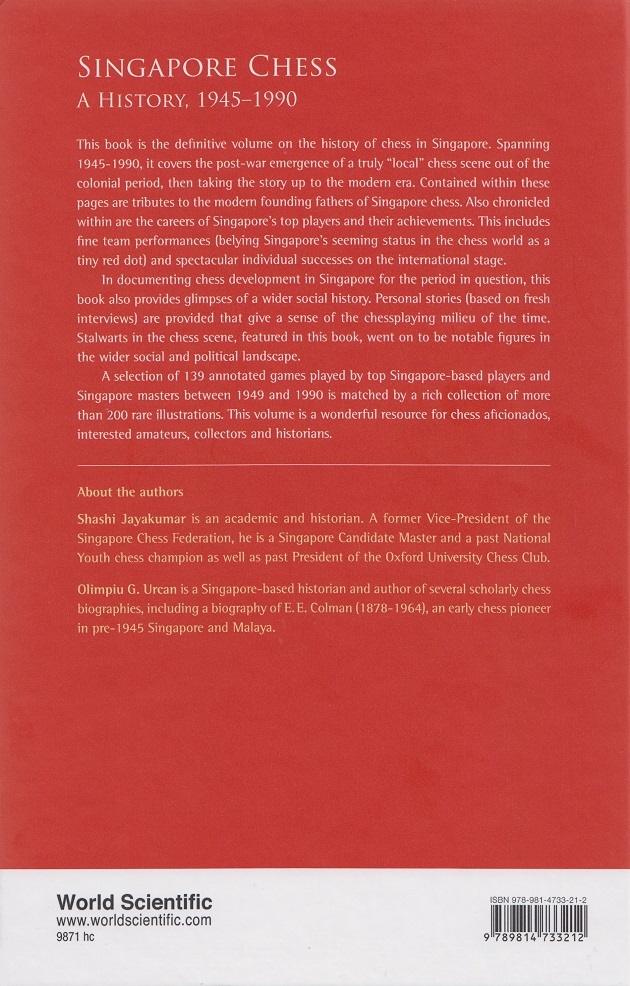
The book is available in hardback and paperback editions.
10568. The Rookie
A paperback edition of The Rookie by Stephen Moss has been published recently. A full page of quotes from reviews of last year’s first edition has been added, but there is no correction of the obvious mistake pointed out in C.N. 10134: page 90 still describes Edward Lasker as ‘a five-times US champion’.
10569. Capablanca and sport
Regarding claims about Capablanca’s sporting prowess, we note that comparisons with Bill Tilden and Bill Johnston were made by Willard H. Mutchler in his chess column on page 9 of the Society section of the Washington Post, 10 August 1924:

10570. A deciphering task (C.N. 10557)


The letter in C.N. 10557 (see part one and part two) lay in a copy of Capablanca’s Hundred Best Games of Chess (London, 1947) inscribed by Harry Golombek to Bruce Hayden. The inscription was shown in C.N. 4478.
Although the closing signature in the letter to Hayden is as difficult to read as much of the text, we can confirm – as Leonard Barden (London) has noted – that the writer was James Gilchrist (1894-1963), who co-authored with David Hooper the Weltgeschichte des Schachs volume on Capablanca (Hamburg, 1963).
Gilchrist’s address, 149 Gray’s Inn Road, London WC1, was in a letter on page 223 of the August 1952 BCM:
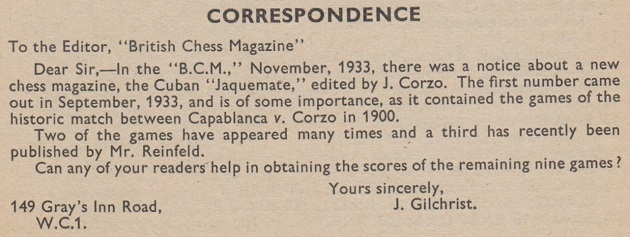
That letter about a 1930s Cuban magazine was mentioned in C.N. 1314 (see pages 193-194 of Chess Explorations) in connection with an earlier BCM report (November 1933, page 463):

We have never found a copy of the 1930s publication Jaque Mate.
B.H. Wood wrote about the Capablanca research of Gilchrist and Hooper in the Illustrated London News, 23 December 1961, page 1122. The final paragraph was an oddity:
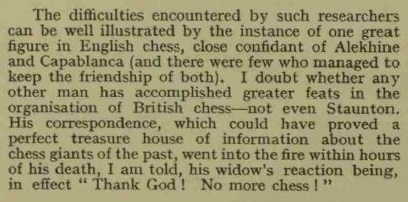
10571. The Quarterly for Chess History
Unperturbed by criticism (in, for instance, C.N. 10200), the Quarterly for Chess History has appeared again, as shambolic as ever.
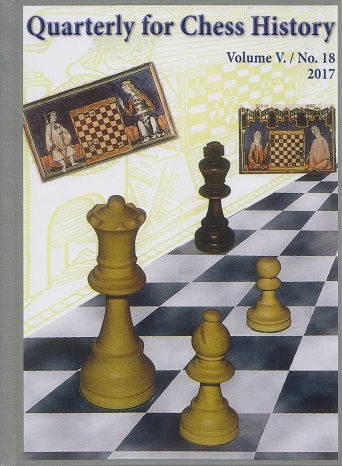
Issue 18 begins (pages 5-84) with the third part of Vlastimil Fiala’s series on F.D. Yates, taking the story all the way from July 1908 to May 1909. The Quarterly ends (pages 565-587, although pages 565-567 would have sufficed) with two book reviews, also by Fiala. Both volumes were published by McFarland, whose name is spelt three ways on page 580. The second book, published nine years ago, is different from the one billed on page 4, in the ‘Content’ [sic].
That same ‘Content’ page lists a section entitled ‘Corrections to Di Felice Chess Result’s [sic] Project’. That feature takes up nearly 30 pages, beginning on page 416 under the heading ‘Chess Reserach [sic]’ in large letters.
Immediately afterwards, Fiala, the Quarterly Editor (whose name appears 14 times in the ‘Content’ – alongside only four other contributors), provides a reminder of his own level of competence. From page 445:
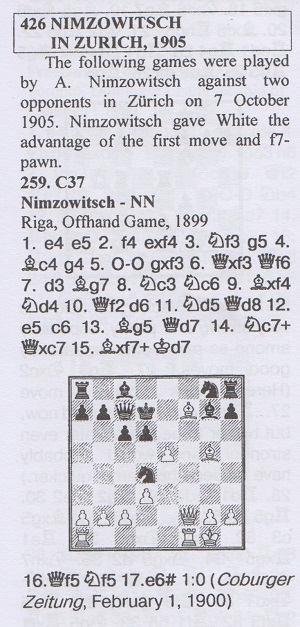
Despite the introductory word ‘games’, there is only one game-score. It was not played by Aron Nimzowitsch, or against two opponents, or in Zurich, or in 1905, or at odds.
The game, won by the master’s father, Schaie Niemzowitsch, was given in C.N. 683. As noted on page 52 of Kings, Commoners and Knaves, it was published on page 77 of Schachjahrbuch für 1899, II. Theil by Ludwig Bachmann:
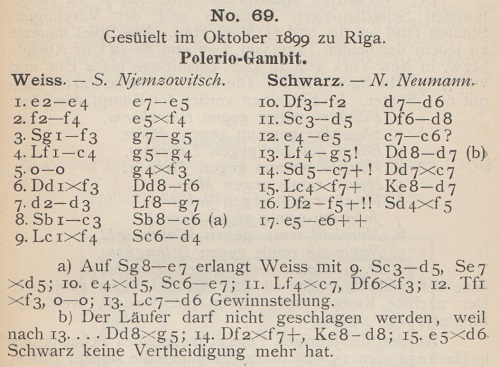
The imprint page of issue 18 of the Quarterly for Chess History (printed in ‘February 2018’):
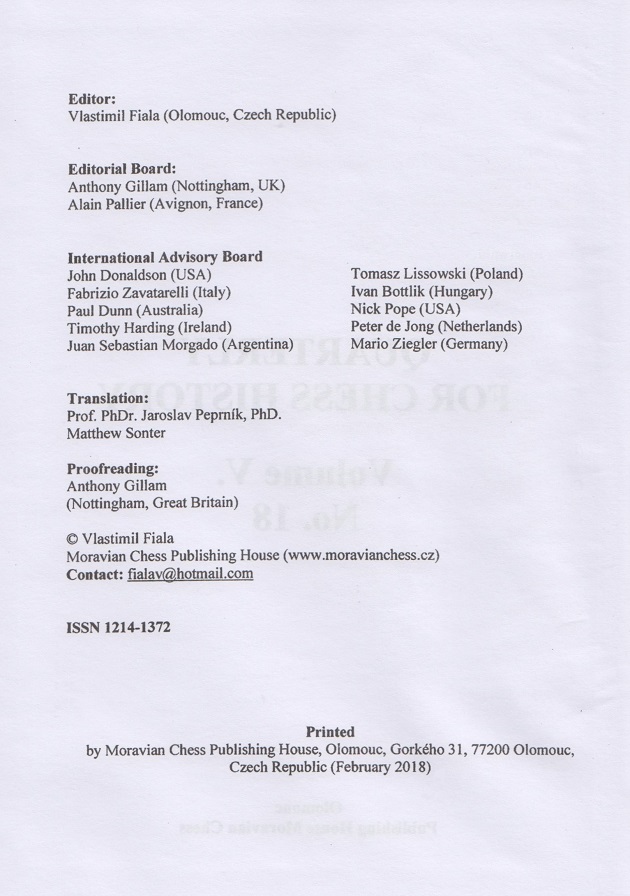
10572. Pillsbury on the Dutch Defence
A game between West and Carr in the First Womanhood Correspondence Chess Tournament was annotated by H.N. Pillsbury on page 59 of issue 43 of Womanhood, 1902. It began 1 d4 f5 2 e4 fxe4 3 Nc3 Nf6 4 Bg5 c6 5 f3, and after Black’s first move Pillsbury wrote:
‘This, an attempt to throw off the yoke of the Queen’s pawn, will probably be abandoned; the series of moves up to White’s fifth move have been played many times, but it remained for Lasker (Paris, 1900) to bring forward the 5 P-B3 move, against which there seems no satisfactory continuation for Black.
It is worthy of note that Morphy preferred 1 P-KB4 [1...f5], but it would probably have been otherwise had he known the continuation of the present game; one of the striking illustrations of the advance chess has made in the period 1860-1900.’
Pillsbury was referring to his loss to Lasker in the 1900 Paris tournament.

Position after 4...c6
5 f3 had been played by Dión M. Martínez against James Mason in Philadelphia on 19 August 1876. Annotating the game on pages 83-85 of the tournament book, W. Henry Sayen wrote regarding 5 f3:
‘White might here have regained the pawn by BxKt, but would have lost all attack. This move is new, and gives a fine attack.’
10573. Argentinian chess portraits
The Cleveland Public Library has sent us a number of photographs of leading Argentinian chess figures, as published on the front cover of the Buenos Aires periodical Jaque-Mate:

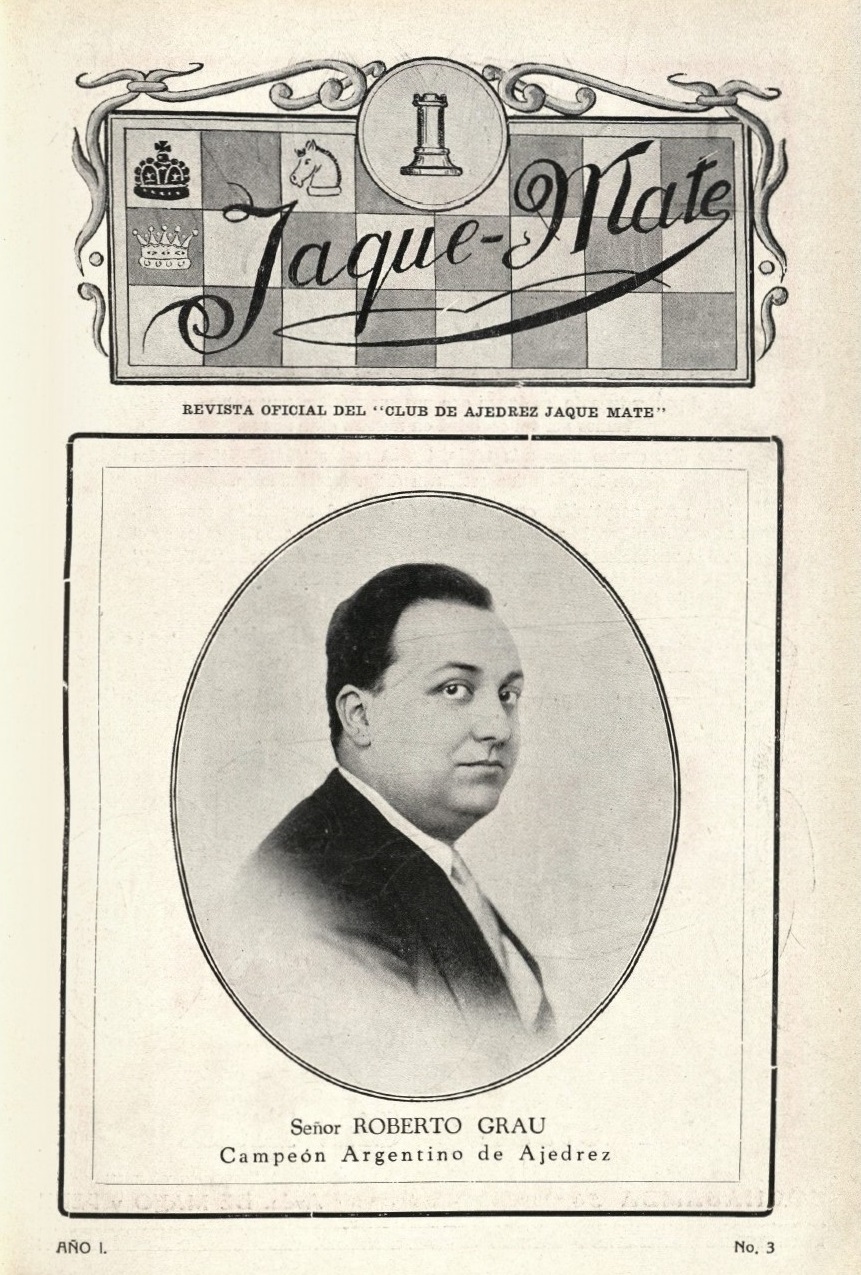

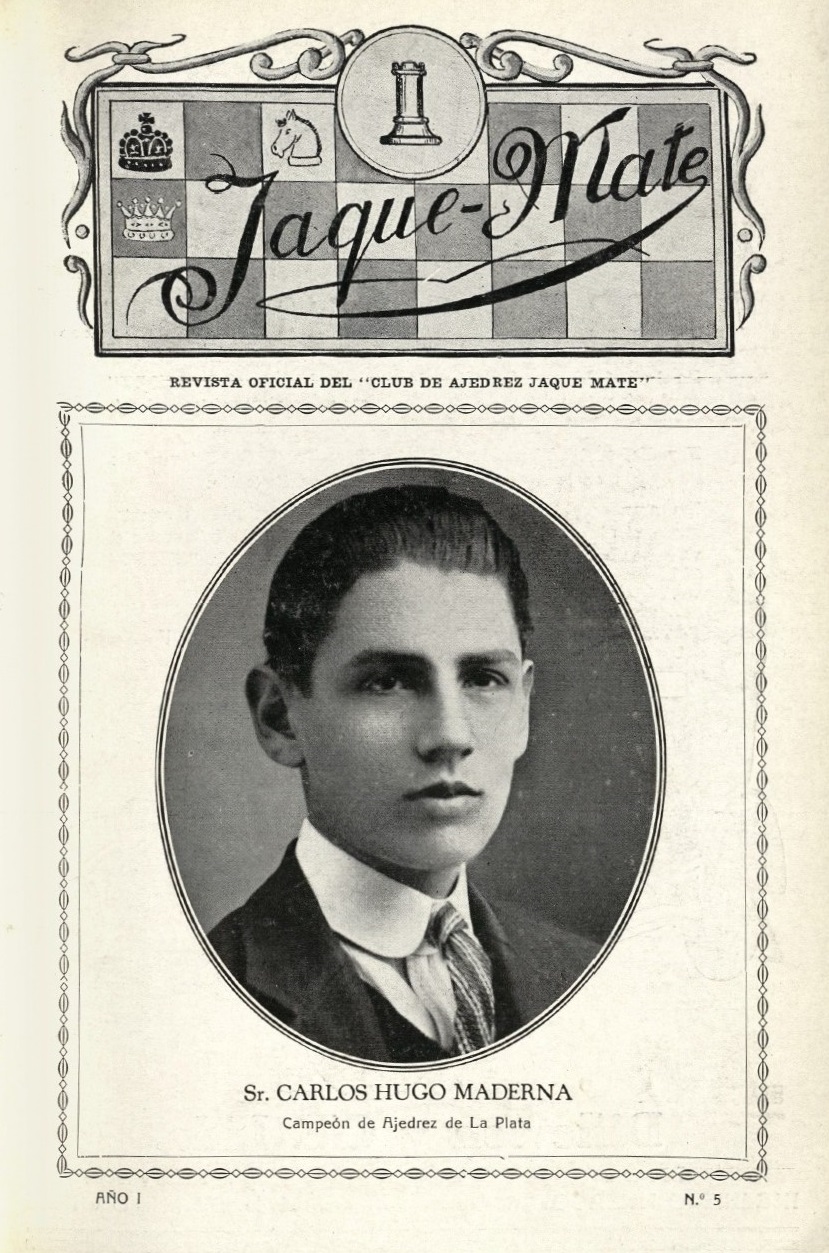
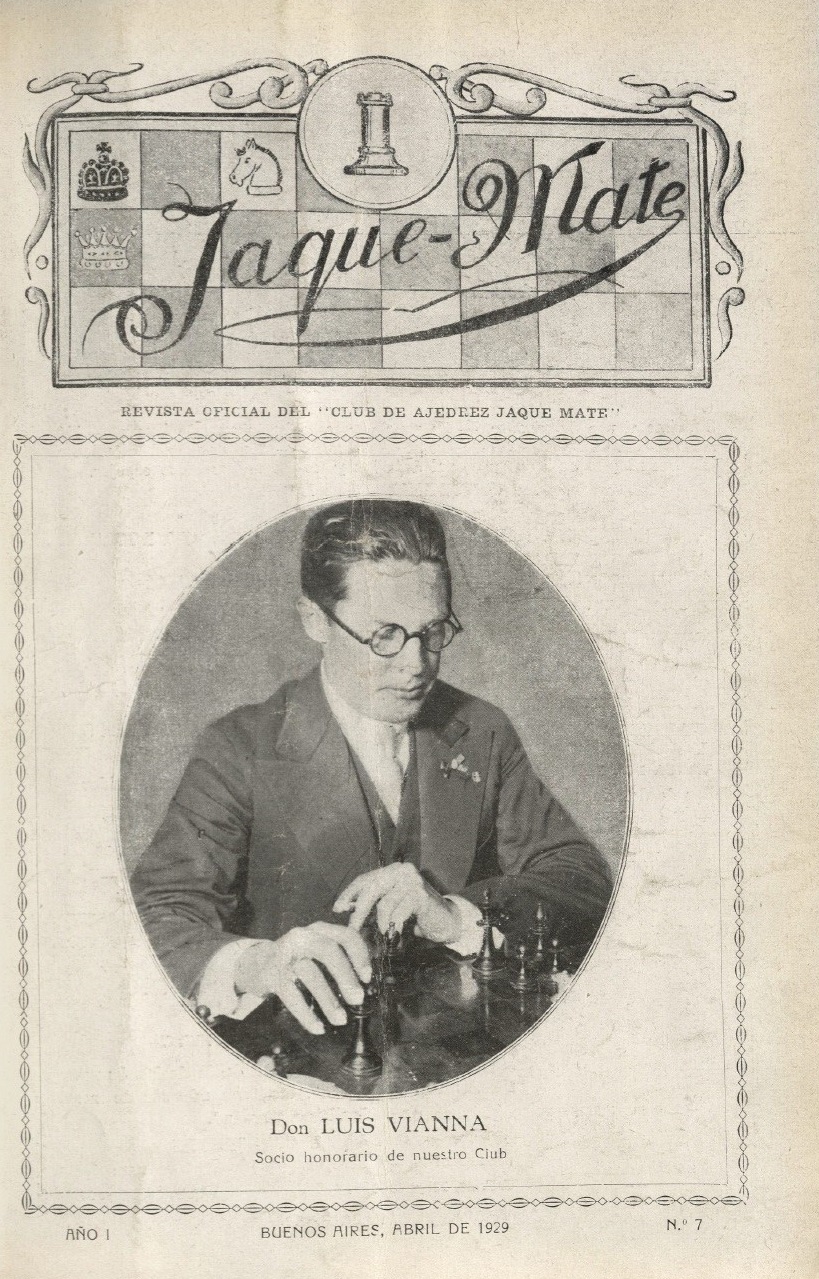

Augusto De Muro
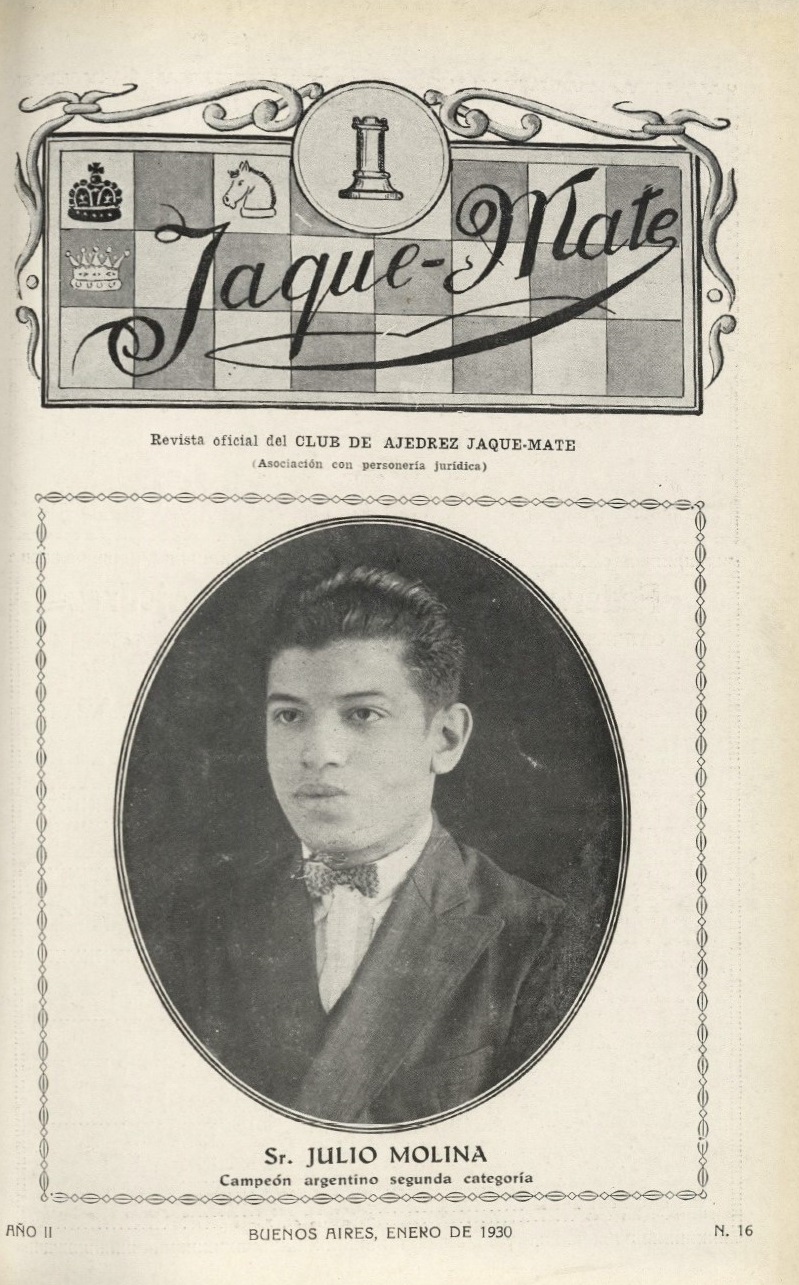
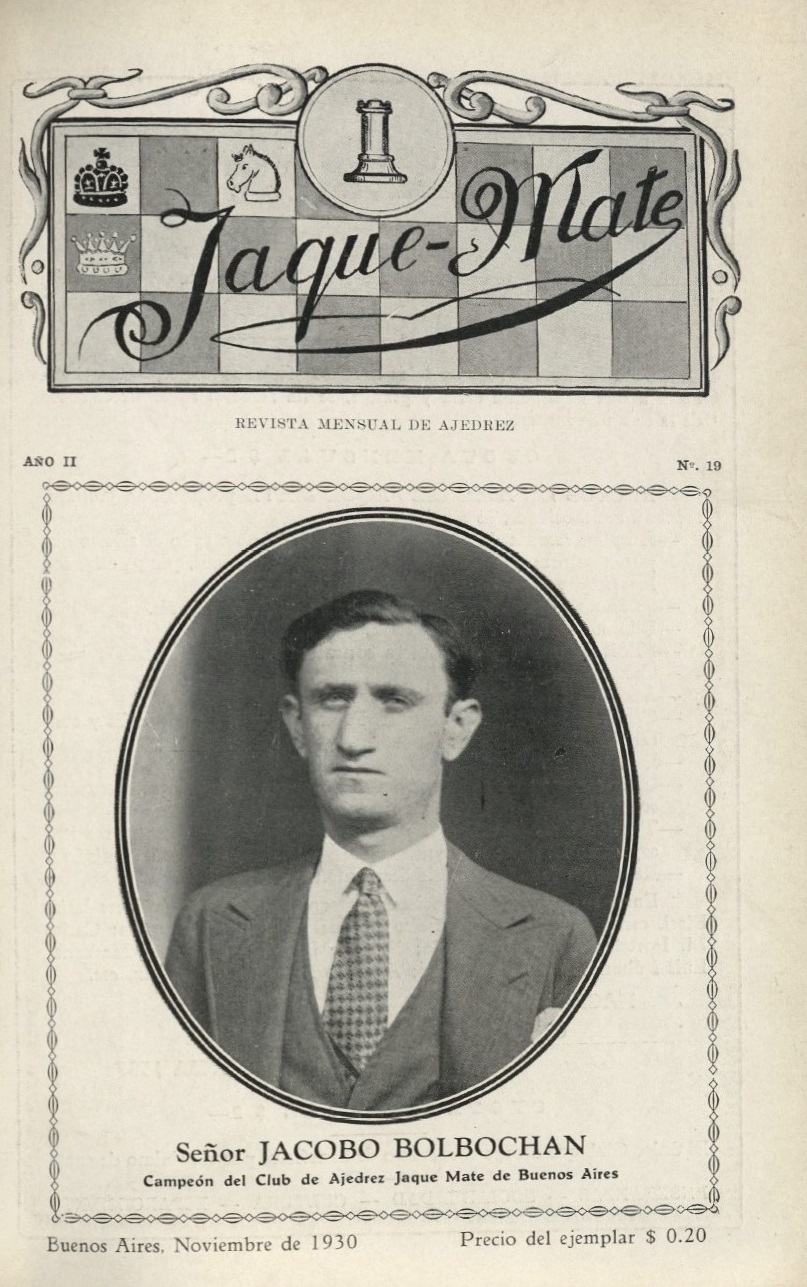
10574. Books and magazines
Readers may appreciate the opportunity to acquire a number of books and magazines from our collection. For instance, we should like to find a good home for sets of books which have given rise to feature articles, e.g. works (many signed) by Ely Culbertson, Reuben Fine, Alfred Kreymborg, Jim Phelan, Hubert Phillips and Sir John Simon. There are also many books on Nardus, Prokofiev and Tolstoy, as well as works authored by, and signed by, Gilbert Highet, a comprehensive set of historical (non-chess) books by P.W. Sergeant, the non-chess books of Fred Reinfeld and volumes on the Wallace murder, Thomas Hood and Tsar Nicholas II. Material related to Birdie Reeve is on offer. Productions by Jeremy Gaige, mostly unpublished, on chess personalia and tournaments can be supplied too, alongside a large collection of juvenilia, chess fiction and poetry.
Various books by Milan Vidmar and Lajos Steiner on electronics are available, as are many non-chess books which have been mentioned in C.N. over the years on account of some connection with our game.
The categories excluded are what might be termed the mainstay of C.N. items (biographical and autobiographical works, tournament books and old magazines), as well as all books and documents inscribed to us. A few books with multiple signatures by leading masters, as shown in C.N. over the years, are unlikely to be yielded for the time being, but many other inscribed items can be requested, as can complete runs of some relatively recent magazines (particularly from the 1980s), postage stamps and photographs.
Enquiries from readers should be as precise as possible and will be dealt with promptly.
| First column | << previous | Archives [157] | next >> | Current column |
Copyright: Edward Winter. All rights reserved.
